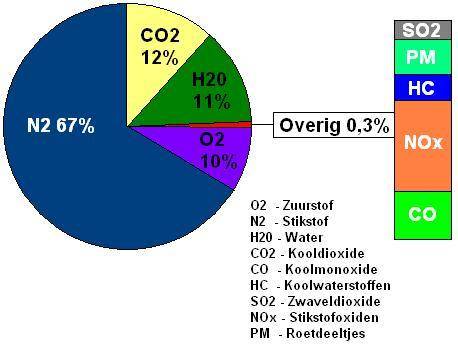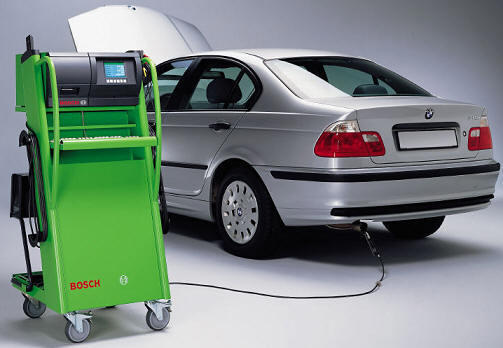Subjects:
- Gasoline engine exhaust
- Diesel engine exhaust
- four-gas tester
Gasoline engine exhaust:
The exhaust gases of a petrol engine contain the following substances:
- CO2: Carbon dioxide (at high concentrations harmful to the environment, humans and animals)
- CO: Carbon monoxide (incompletely burned gas, also harmful to health)
- CH: Hydrocarbons (unburned gasoline parts)
- O2: Oxygen parts (which did not participate in combustion)
- NOx: Nitrogen compound (which is only formed under very high combustion temperatures.
De catalyst converts the three harmful components CO, HC and NOx into 3 harmless components: CO2, H2O and N2. The name three-way catalytic converter also comes from here.
| Harmful substance: | Add from: | Results in: |
| CO+ | O2 = | CO2 |
| HC+ | O2 = | CO2 + H2O |
| NOx+ | CO = | N2 + CO2 |
Enrichment takes place at a cold start; there is then a surplus of fuel. Extra CO and HC are emitted during a cold start. Since the catalytic converter has not yet reached its operating temperature during a cold start, these substances cannot yet be converted. With help from secondary air pump extra air is added to the exhaust gases. The additional air supplied increases the temperature of the exhaust gases and heats up the catalytic converter faster. The harmful substances can be converted more quickly after a cold start.
Despite the fact that manufacturers make every effort to reduce the harmful parts in the exhaust gases, this takes place even with optimum combustion. The European Union nevertheless obliges the manufacturers to make the new engines increasingly “cleaner”. The limits of the emissions are laid down in the emission standard. The table below shows the EU standards of a petrol engine:
| Intership | Effective | NOx | HC | NMHC | HC+NOx | CO | PM |
| Euro 1 | 1993 | - | - | - | 970 | 2720 | 140 |
| Euro 2 | 1996 | - | - | - | 500 | 2200 | - |
| Euro 3 | 2000 | 150 | 200 | - | - | 2300 | - |
| Euro 4 | 2005 | 80 | 100 | - | - | 1000 | - |
| Euro 5 | 2009 | 60 | 100 | 68 | - | 1000 | 5 |
| Euro 5b | 2011 | 60 | 100 | 68 | - | 1000 | 4.5 |
| Euro 6 | 2014 | 60 | 100 | 68 | - | 1000 | 4.5 |
Exhaust gases from a diesel engine:
- 67% Nitrogen (N2)
- 12% Carbon Dioxide (CO2)
- 11% Water (H2O)
- 10% Oxygen
- 0,3% other substances, including soot particles (PM), Hydrocarbons (HC), Nitrogen oxides (NOx), Carbon monoxide (CO)
Nowadays, a three-way catalytic converter is increasingly used in diesel engines to convert the minimum amount of CO into CO2 and H2O.

The EU standards also apply to diesel engines, of course. Thanks to technical developments, the emissions of the substances CO2, nitrogen oxides and soot particles have decreased significantly in modern diesel engines. Since 1990, soot emissions from diesel engines have decreased by 99%. dThe table below shows the EU standards of a diesel engine:
| Intership | Effective | NOx | HC+NOx | CO | PM |
| Euro 1 | 1993 | - | 970 | 2720 | 140 |
| Euro 2 | 1996 | - | 700 | 1000 | 80 |
| Euro 3 | 2000 | 500 | 560 | 640 | 50 |
| Euro 4 | 2005 | 250 | 300 | 500 | 25 |
| Euro 5 | 2009 | 180 | 230 | 500 | 5 |
| Euro 5b | 2011 | 180 | 230 | 500 | 4.5 |
| Euro 6 | 2014 | 80 | 170 | 500 | 4.5 |
Four-gas tester:
During an exhaust gas test of a car with a petrol engine, for example during the APK, the values are read from the four-gas tester. A probe is inserted into the exhaust and the engine must run at an increased speed. The engine must be at operating temperature. This exhaust gas test looks at:
- HC (guide value: 20 – 100 ppm)
- CO (guide value: see APK requirements)
- CO2 (guide value: 15 – 16%)
- O2 (guide value: as low as possible)
The judge assesses these values. If these values are not within the tolerances, the car will be rejected.

When the values fall outside the tolerances, this can have many causes. The information below will help you find the cause:
HC too high:
- lean mixture, cylinder over-load;
- rich mixture;
- oil consumption;
- ignition failure.
CO too high:
- too rich mixture;
- ignition timing (too early or too late);
- Carter ventilation;
- tank extraction / activated carbon filter.
CO2:
- A high CO2 content indicates that the combustion has been completed. A CO2 level that is too low is a result of a lean mixture or leakage in the exhaust.
Q2:
- Incomplete combustion and / or a leak in the exhaust creates a high O2 value.
| CO | CO2 | HC | O2 | Possible causes |
| H | L | H | H | Rich mixture, ignition problem |
| H | L | H | L | Engine temperature too low due to defective thermostat or temperature sensor |
| L | L | L | H | Exhaust leak after the catalytic converter |
| L | H | L | H | Lean mixture, problem with injection system |
| H | L | GL | L | Rich Blend |
| H | H | H | H | Injector and/or catalytic converter problem: Rich mixture and false air combination |
| L | L | H | H | Ignition problem, lean mixture, false air |
| L | H | L | L | Good combustion and well-functioning catalytic converter |
